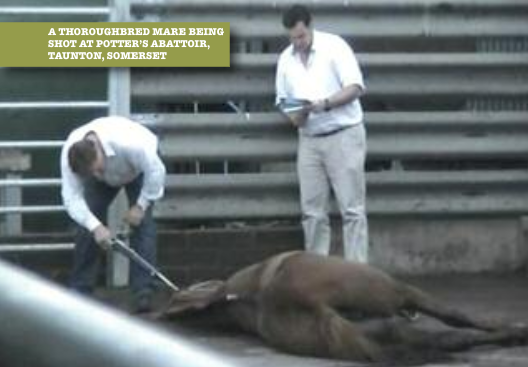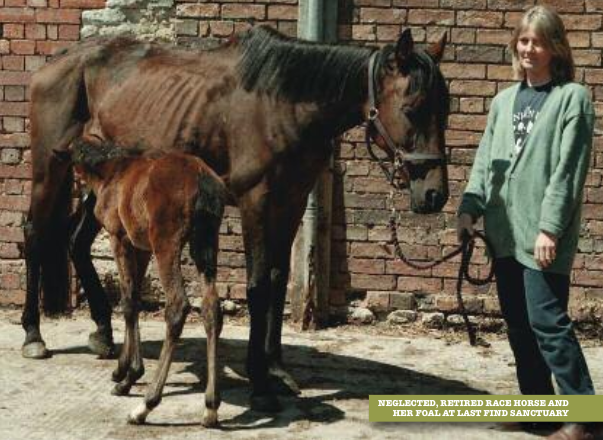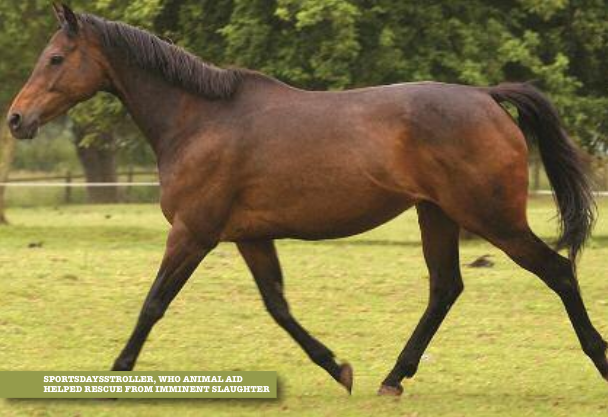Note: this article is written with an emphasis on the horse racing industry in the United Kingdom, though many of the larger themes explored here are present in other nations’ horse racing industries as well.
The image the racing industry promotes is that of harmless sport in which its prize asset – the Thoroughbred race horse – is cosseted and treated like a king. Occasionally, it is acknowledged, race course ‘accidents’ happen and an animal dies. But all sports, the industry goes onto argue, including those involving people, produce victims.
In reality, no other sport comes close to matching racing’s attrition rate. If it did, a ban would quickly be imposed. Approximately one in every 37 horses who starts a season’s racing will have perished by the end of it. They will have died as a result of a racecourse or training injury, or they will be killed after being judged to be no longer financially viable.
Far from being cosseted, race horses are typically confined to their stables for much of the day. They are released for short, intense periods of exercise and to travel – sometimes great distances – to and from race meetings. They are confined for such long periods, with feed brought to them, that some even have to be taught to eat grass once their racing days are over.
There is little financial provision for race horses at the ends of their careers. Many are shot or lethally injected at their stables, or they are sent for slaughter. In 2007, Animal Aid secretly filmed apparently healthy but unwanted Thoroughbreds being shot in the head and butchered at a slaughterhouse in the English town of Taunton.
Breeding
Approximately 13,000 foals are born into the closely related British and Irish racing industries each year.
There are many crude jokes about the supposedly perfect life of the breeding stallion. But his is an existence of near isolation and deadening routine. Barring physical breakdown, it can go on for 20 or more years.
During the six month breeding season, a stallion can be required to ‘cover ’ three mares a day. Outside the breeding shed, he is kept separated from mares and other males. When not housed in his stable, he is likely to be confined behind high fences.
Breeding females are subjected to drugs and prolonged periods of artificial light to control and speed up reproduction. Left to their own devices, mares in the wild have one foal every two years, or perhaps two every three years. They deliver in the spring, after a pregnancy lasting 11 months. The racing industry forces many mares to produce a foal every year until late in life – a burden of almost constant pregnancy.
The industry is ruthless when sizing up the potential of newborn foals. There has been an increase in foal ‘production’ of around 125 percent since the 1960s. Approximately 20 percent of Thoroughbreds born will never race, and a substantial majority will have careers of just two or three seasons. Some of the ‘failures’ are taken up by other equestrian events but most can not be accounted for. The evidence points to a significant proportion being killed at their yards, fed to hunting hounds, or butchered for meat.
Why is there so much ‘over-production’? Owners and breeders are hooked on the promise of big prizes and glory. They breed speculatively, hoping to produce an ‘X Factor’ champion. When horses come up short – as most inevitably will – there is a good chance that they will be disposed of.
Horses were once bred with different characteristics, depending on whether they were to race over jumps or over short or long distances on the Flat. Jump-race horses would be heavier-boned and sturdier.
The world’s dominant breeders now produce a ‘one model fits all’ animal who is asked to do a variety of jobs that he or she can no longer safely undertake. Speed is a key requisite for this modern all-purpose Thoroughbred – at the expense of skeletal strength and general robustness.
The consequences are felt, especially by horses entered into jump racing – the sector responsible for 80 percent of racecourse fatalities. But animals racing on the Flat also suffer a high casualty rate. Amongst a typical group of 100, one fracture will occur every month. Typically, race horses die – or are killed – as a result of a broken limb or neck, severe tendon injuries, spinal injuries or a heart attack.
One horse dies on a British racecourse every two days of racing, even though these deaths are rarely reported in the media.
Serious racing-related illnesses such as bleeding lungs and gastric ulcers are now also endemic. Eighty-two percent of Flat race horses older than three years of age suffer from bleeding lungs (Exercise-Induced Pulmonary Hemorrhage), which can cause blood to leak from the nostrils. Gastric ulcers are present in no fewer than 93 percent of horses in training, in whom the condition gets progressively worse. When horses are retired, the condition improves.
Use of the whip
Horses are the only animals who may be beaten in public for entertainment in the United Kingdom. That is why Animal Aid has campaigned for many years to ban the whip from racing in Britain.
Our research showed that the British Horseracing Authority’s (BHA) rules on the whip were being regularly and repeatedly flouted by jockeys, with 887 breaches during 2010, and 15 jockeys each committing 10 or more offences. In the first six months of 2011, 10 horses were wealed by the BHA’s so-called welfare-friendly cushioned whip.
A long-awaited review of the whip was published by the BHA in 2011. However, following several bouts of rebellion from disgruntled jockeys, the new rules were watered down and former restrictions on whip strikes became merely a guideline – leaving horses who are repeatedly hit vulnerable to the subjective discretion of the Stewards as to whether or not they have been abused.
The case for an outright whip ban is stronger than ever. In 2012, a new international initiative was launched, spearheaded by Animal Aid and supported by animal advocacy groups in Australia, France, Germany and the Republic of Ireland – countries in which there are strong horseracing industries.
Norway banned the whip in 1982 – an action that has been met with the enthusiastic approval of racecourse officials, horse trainers and spectators, according to Hans Petter Eriksen, administrative director of the Norwegian Jockey Club.
When racing has finished
Around 7,500 horses leave racing each year. ‘Despite all the [racing industry]initiatives and PR, there is a black hole in the records on the fates of ex-race horses,’ according to an investigation by Horse & Hound magazine.
 There is very little detailed analysis of the fates of ex-race horses. But a telling report was published by the BHA in response to criticism by Animal Aid. It showed that of the 7,590 horses who left racing in 2006, around 43 percent were either dead or not traceable just two years later. 852 were reported dead, while the whereabouts of 2,404 were not known.
There is very little detailed analysis of the fates of ex-race horses. But a telling report was published by the BHA in response to criticism by Animal Aid. It showed that of the 7,590 horses who left racing in 2006, around 43 percent were either dead or not traceable just two years later. 852 were reported dead, while the whereabouts of 2,404 were not known.
Given such dismal statistics, it is unsurprising that the various branches of the multi-billion pound racing and betting industry allocate a comparative pittance to retired race horses. The total revenues in official schemes amounted to less than 1 million pounds in 2010 and those same official channels are managing to retrain fewer than 200 ex-race horses each year.
Conclusion
The evidence points to a hard-headed, exploitative industry that – not withstanding the soft-focus PR message –treats race horses as disposable commodities. It routinely produces more Thoroughbreds than racing can accommodate but takes virtually no responsibility for the ‘surplus.’ Unwanted horses are sold to whoever wishes to buy them or they are killed in their yards or sent for slaughter. The hundreds of annual racecourse and in-training deaths are often written off as unforeseen accidents. Sometimes, as many as four horses perish in a single day at one racecourse. Terms such as ‘statistical blip’ are used to explain such carnage.
Animal Aid has investigated the horse racing industry for more than 15 years, producing several detailed reports and conducting a series of undercover investigations. Our evidence leads us to the conclusion that it is an industry that does not warrant public support in the form of betting income, racecourse attendance fees or commercial sponsorship.
The pdf version of this briefing can be accessed here.
Featured image: a horse race. Image credit Ken Munson Photography, CC BY-SA 3.0. All other images in this story via Animal Aid UK.









